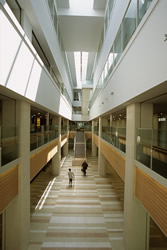Last Uploaded: April, 2011
Keio University Hiyoshi Campus Collaboration Complex
 |
| Top light (Passage of Knowledge) (Photograph: Mitsumasa Fujitsuka) |
 |
 |
 |
|
| |
|
|
|
 |
Special Features
| Q-1 Indoor Environment |
- Soundproofing features of Fujiwara Hiroshi Hall including six-sided floating floor structure
- Top lights
- Minimum 2.0% daylight in training/accommodation rooms
- JIS/JAS rated F☆☆☆☆ materials used throughout
- Ventilation volumes in individual training/accommodation rooms designed at 40% above Building Standards Act (60 - 120 CMH per room)
- Smoking prohibited inside building except in designated smoking booths on training/accommodation floor
|
| Q-2 Quality of Service |
- Heart Building Law compliant
- Excellent earthquake protection
- Seismic isolation structure
- Tiled precast concrete boards for exteriors
- Main internal finishes designed to last at least 20 years before replacement
- Water-saving fixtures and fittings
- Multiple heat sources in heating/cooling system (gas and electricity)
- Ceiling height = 4.15 m in school section, 3.6 m in training/accommodation section
- Minimum floor load = 4,900 N/m2 in school section
- Spare capacity in vertical power and data cable ducts
|
| Q-3 Outdoor Environment on Site |
- Sunken garden with open plaza for large gatherings, on the grounds and to the subway station entrance.
- Facilities for engaging with the local community on first and second levels of building
- Waterscape incorporated into Sunken Garden
- Pedestrian routes along southern road edge of site area
- Japanese keyaki trees along Tsunashima Kaido
|
| LR-1 Energy |
- Cogeneration system
- Ice thermal storage system
- BEMS
- Natural light from top lights
- External ventilation cooling system
|
| LR-2 Resources and Materials |
- Main toilets with automatic flush, water-saving toilets and recorded flushing sounds.
- Electrosteel framing members such as beams and studs
- Blast-furnace cement piles
- Recycled materials
- Nitrogen-based inert gas fire extinguishers
|
| LR-3 Off-site Environment |
- Energy-saving equipment and facilities
- Use of ventilation in cooling system to minimize heat source load
- Peak shifting via ice thermal storage
- Kitchen exhaust ported through to rooftop
- Waste storage facility below ground level to contain odors
|
Other Features
These cases are described based on assessment results obtained using
CASBEE.
CASBEE is a method for rating the environmental performance of buildings using
Building Environmental Efficiency (BEE) as an indicator, which is based on the results of
separate scores obtained for Q-1~Q-3 (Quality) and LR-1~LR-3 (Load Reduction).










 Next Building
Next Building















 | Copyright © 2008 Institute for Building Environment and Energy Conservation, All Rights Reserved.
| Copyright © 2008 Institute for Building Environment and Energy Conservation, All Rights Reserved.